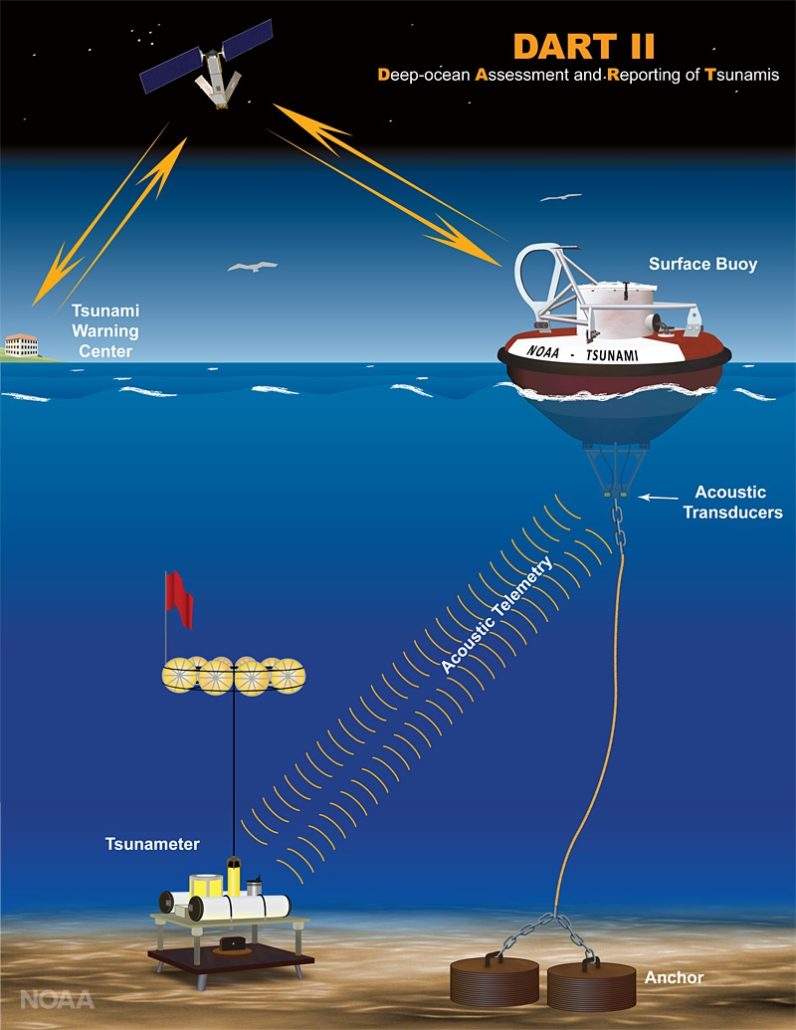Tsunamis are a scary and devastating natural phenomenon. On average, two damaging tsunamis occur globally each year. A major, devastating, ocean-wide tsunami occurs roughly every 15 years. To prevent catastrophic loss of life, many countries have independently or jointly developed tsunami early warning systems. Indonesia was hit with a massive earthquake and subsequent tsunami last month, and their warning system failed. To understand how these systems work and how they can fail, it is important to understand the causes of tsunamis. At the most basic, a tsunami is caused by a large, sudden motion on the seafloor. Earthquakes beneath or near the ocean most commonly cause this motion, but other potential causes include volcanic eruptions, underwater landslides, or even an above water landslide, such as a large piece of ice breaking off an iceberg or a meteor striking the ocean.
How Tsunami Early Warning Systems Work
Since a vast majority of tsunamis are caused by seismic activity on the seafloor, warning systems start with seismic monitoring. Sensors on the seafloor monitor for seismic activity caused by earthquakes and volcanoes. If a substantial seismic incident occurs, surface buoy sensors then monitor for changes in the sea level. Tsunami waves could be as shallow as three feet high, so these sensors are placed in an array to determine motion as well as height. These seafloor and surface buoy sensors send data to tsunami warning centers, which are staffed 24/7. The centers monitor the data, perform analysis, and quickly determine whether conditions are met to issue a tsunami warning alert. If an alert is sent, it goes to local radio and television, wireless emergency alerts, NOAA Weather Radio, and NOAA websites. Some tsunami threat areas might also issue warnings through sirens, text message alerts, and phone notifications.

NOAA’s Deep-ocean Assessment and Reporting of Tsunami System (NOAA)
What Failed in Indonesia?
On September 28, 2018, a 7.5 magnitude earthquake hit Sulawesi, Indonesia. A tsunami alert was briefly issued cautioning a possible tsunami of 0.5 meters, before a tsunami struck the city of Palu. The tsunami that hit was later estimated to be closer to 5 or 6 meters, causing widespread destruction and leading to over 7,000 people confirmed dead or never found. Another 10,000 people were reported injured.
“Indonesia built a network of buoys for detecting tsunamis, but due to lack of maintenance, the system is no longer operational”
Following the tsunami, officials in Indonesia faced heavy criticism for failing to warn the people of the severity of the incident, and several investigations were conducted into what failed within the system. As is common with system failures of this magnitude, several factors combined to bring about the failure.
Detection: Indonesia built a network of buoys for detecting tsunamis, but due to lack of maintenance, the system is no longer operational. Their closest tidal gauge was 125 miles away from Palu, and only recorded a 2.3 inch rise in water level. These tidal gauges are not primarily intended to detect tsunamis, since their sample rate is only every 15 minutes. Seismometers alone proved inadequate to predict the severity of the tsunami.
Warning: Cell phone towers in the area had already been damaged and were inoperable due to the earthquake that preempted the tsunami and many areas did not receive cell phone alerts. Palu was seen as a fairly protected city due to its deep bay and surrounding mountains. Due to this perceived natural protection, the beach regions were not equipped with warning sirens. The geography of this bay likely contributed to the severity of the tsunami instead of protecting the bay by funneling the water to a concentrated point, similar to how a narrowing river speeds up the flow.
Due to the limitations of the detection and warning systems in Indonesia, officials are stressing educating the public that any earthquake lasting longer than 20 seconds is a tsunami threat. If an earthquake occurs, they recommend getting to higher ground immediately and not waiting for a warning.
Sources:
https://www.usgs.gov/faqs/what-are-tsunamis?qt-news_science_products=0#qt-news_science_products




One Comment